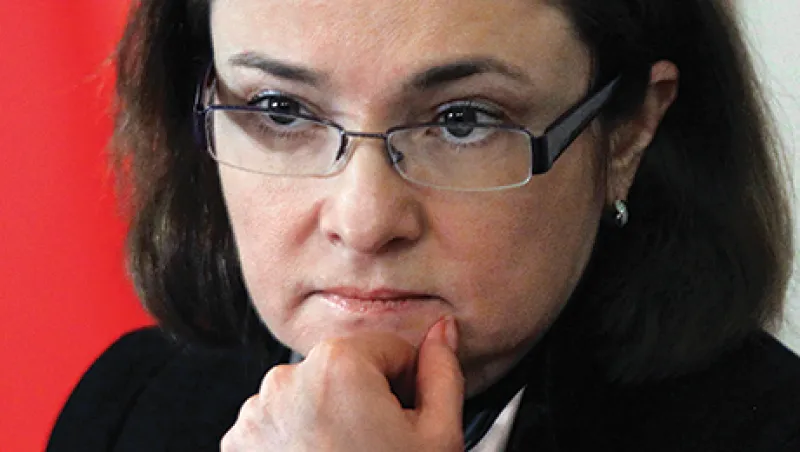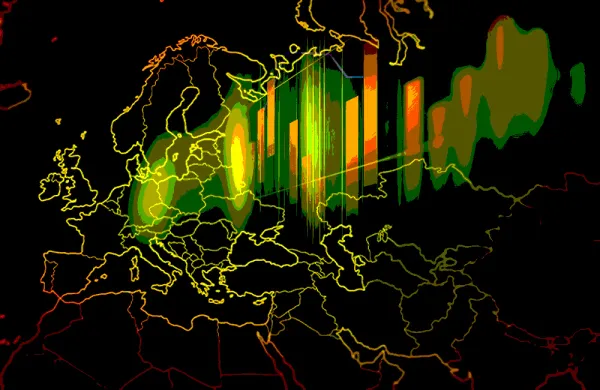Ksenia Yudaeva wants to make one thing perfectly clear: She and her colleagues at the Central Bank of the Russian Federation are taking the punch bowl away. The economy has slowed for four straight quarters, and the International Monetary Fund is projecting only a modest rebound, to a 3 percent rate in 2014 from 1.5 percent in 2013, but looser credit would make things worse, contends Yudaeva, 43, the central bank’s freshly minted deputy governor in charge of monetary policy.
“Our analysis shows that the economic slowdown is caused by structural, not cyclical, factors,” Yudaeva tells Institutional Investor in an interview in her office at the stately mansion near the Kremlin where the central bank has been based since the 19th century. “Any attempt to use monetary stimulus would only lead to inflation.”
Instead of priming the pump, the CBR is focusing on bringing the growth rate of consumer prices — which stood at 6.3 percent in October — within its target levels of 6 percent this year and 4 percent by 2016. Lower inflation will encourage the long-term investment that Russia desperately needs, Yudaeva insists. “We will do everything we can to reach our inflation targets,” she says. “We are very committed.”
Such hawkishness is not what markets expected when Yudaeva’s boss, Elvira Nabiullina, took over as governor of the central bank in June, ending the 11-year reign of Sergei Ignatiev. She inherited an institution in transition. Beginning in 2011 the former governor began shifting the main thrust of Russia’s monetary policy from managing the ruble exchange rate to targeting inflation, bringing the CBR into line with most central banks in both developed- and emerging-markets countries. But that process is not due to be completed until 2015, and even then the inflation target is supposed to be set jointly by the central bank and the government and approved by the Duma, leaving plenty of room for politics to influence monetary policy.
Nabiullina, 49, has long been a political animal, spending most of her career in government, rising under the tutelage of Vladimir Putin and Herman Gref, an architect of the president’s early economic policies. She served as Gref’s first deputy for three years in the early 2000s, when he was minister of Economic Development. Gref moved to Sberbank as CEO in 2007, and Putin tapped Nabiullina to replace him as minister. When Putin returned to the presidency in 2012 after a term as prime minister, he brought Nabiullina into the Kremlin as his chief economic adviser.
As minister, Nabiullina advocated some fiscal laxity to boost the economy. She joked about her run-ins with then–Finance minister Alexei Kudrin, telling reporters it was “difficult but always interesting” to work with the austere budget master.
Ignatiev was a stout defender of the central bank’s independence, but he faced heavy political pressure to ease policy in his last months in office. In January, First Deputy Prime Minister Igor Shuvalov called on the CBR to reduce interest rates by a full percentage point.
Since succeeding Ignatiev, Nabiullina has shown plenty of steel herself. In her monthly appearances before the Duma, she has bluntly explained that rates — which the central bank last raised, by a quarter point to 5.5 percent, in September 2012 — are on hold and likely to remain that way. “Our old model of development, based on continually rising raw material prices, has obviously exhausted itself,” she told lawmakers in November. “We have exhausted the possibilities for growth through occupying idle capacity, increasing employment, raising wages or increasing consumer credit.”
In September, Nabiullina brought in Yudaeva — a confident figure with fluent English polished while earning an economics doctorate at the Massachusetts Institute of Technology — as her first top-ranking appointee. Yudaeva launched her career at two Moscow bastions of economic liberalism: as a professor at the New Economic School, then as a fellow at the Russian office of the Carnegie Endowment for International Peace. In 2006 she moved to a Kremlin-backed think tank, the Center for Strategic Research, as its head. From 2008 to 2012, during the presidency of Dmitry Medvedev, she ran Sberbank’s Macroeconomic Research Center. When Putin regained the presidency, he tapped Yudaeva to head his Economic Experts Department and be his Group of 20 Sherpa.
As if the threat of recession were not enough challenge, Nabiullina’s appointment coincides with the CBR’s elevation to the role of super–financial regulator. In September it took up the task of overseeing Russia’s securities markets, pensions and insurance industries, replacing several little-loved bureaucracies. Nabiullina gave this job to Sergey Shvetsov, a deputy governor retained from the Ignatiev team (see also “Russia’s New Superregulator Vows to Enhance Corporate Governance”).
Some in Moscow continue to agitate for a softer monetary line from the CBR. Among them is Herbert Moos, deputy chairman of the country’s No. 2 bank, VTB. Although monetary policy may seem easy, with the central bank’s key refinancing rate set below the inflation rate, banks have to charge much higher lending rates because Russian law and judges make it difficult to seize collateral in the event of default, discouraging borrowing and contributing to Russia’s economic malaise,he says. “We are lending at 12 percent, and who can afford to borrow at that rate?” Moos asks.
But others see the central bankers’ point of view, and the political drumbeat for cuts has died down for the moment. “The team at the central bank is very professional,” says Anatoly Aksakov, who is vice chairman of the Duma’s Committee on Credit Organizations and president of the Association of Regional Banks. “I have no complaints so far.”
Analysts and investors, concerned by the ruble’s 7 percent decline against the dollar this past year, have reacted well to the CBR’s tough stand. “Holding interest rates is the right thing to do,” says Yaroslav Lissovolik, Deutsche Bank’s Moscow-based chief economist for Russia. “The market was expecting more dovishness and has been pleasantly surprised.”
The ruble has held steady since Nabiullina took office, even as other emerging-markets currencies have slipped. Russia’s stock market, the sick man of the developing-markets equity universe in recent years, has turned into an outperformer: Investors value its macroeconomic solidity compared with markets in countries like Brazil and India, which appear more vulnerable to capital outflows in response to anticipated interest rate increases in the U.S. The benchmark Micex Index climbed 15.8 percent during Nabiullina’s first five months at the central bank, compared with a 13 percent rise for the global MSCI Emerging Markets Index.
But the central bank leadership’s assessment that Russia needs new growth drivers could give optimistic investors pause. Between 2000 and 2008 soaring prices for oil, gas and other commodities fueled a boom in which the economy expanded at a rate of 5 to 7 percent a year. Oil has plateaued at high levels but is not expected to rise again sharply any time soon.
Russian GDP plunged by nearly 8 percent in the crisis year of 2009, but a large government stimulus program helped boost growth back to an average rate of about 4 percent between 2010 and 2012. That rebound effect has run its course now, with output back above precrisis levels and unemployment standing at just 5.5 percent, Yudaeva says. Another factor in the postcrisis growth spurt was a boom in borrowing by Russia’s relatively unleveraged consumers. Today credit growth has slowed markedly, from some 40 percent in 2012 to about 30 percent in 2013, not least because Ignatiev’s central bank applied the brakes by imposing higher reserve requirements on banks and ratcheting up risk weightings on loans carrying higher rates of interest — policies that his successor strongly endorses. “We observe an excessive rise in levels of indebtedness compared to income,” Nabiullina told the Duma in November. “As a result, consumer credit may become less an engine of growth than a threat to financial stability.”
In sum, the new CBR leadership believes that Russia can return to healthy expansion only the hard way: by marshaling investment capital to improve productivity, something the country has struggled to do for the past 20 years. “The country needs a new model of growth, which has to be driven by investment growth,” Yudaeva tells II.
Increasingly, that tough view is shared by the government. In November the Ministry of Economic Development slashed its projection for growth through 2030 to a modest 2.5 percent a year from 4 percent previously.
No less a figure than Prime Minister Medvedev has compounded the gloom, telling Reuters in a recent interview: “There is no magic formula to boost growth. In any case, if there is, we do not know what it is.” Putin himself decried Russia’s poor productivity, which the Organization for Economic Cooperation and Development estimates at just 39 percent of U.S. levels, at an investment conference organized by VTB in October. His vague solution: Force state companies “to fulfill their investment programs by cutting expenses.”
CREATING A COMPETENT CENTRAL bank and a more trustworthy banking system have been among the important economic achievements of Putin’s tenure in power, which began with his ascension to the presidency in 2000, succeeding Boris Yeltsin. The Economist magazine famously called Viktor Gerashchenko, who ran the CBR for much of the 1990s, “the world’s worst central banker,” with considerable cause. Monetary policy based on the printing press yielded hyperinflation that peaked at more than 1,000 percent in the 1990s, while an absence of proper supervision spawned an opaque universe of 1,300 or so licensed banks. Most of the larger private institutions simply disappeared after the 1998 financial crisis, taking customers’ money with them.
In 2002, Putin nominated Ignatiev to replace Gerashchenko and bring order to Russia’s financial system. The magnitude of the task was underscored in 2006, when Andrei Kozlov, Ignatiev’s deputy in charge of banking supervision, was gunned down outside a Moscow stadium after leaving a soccer game with central bank colleagues. Two years later Alexei Frenkel, the owner of several banks whose licenses the CBR had revoked, was convicted of organizing the murder. Reform continued despite the attempted intimidation. Tougher supervision by the central bank helped reduce the banking industry to fewer than 1,100 institutions, and the government introduced federal deposit insurance, covering deposits up to 700,000 rubles ($21,500), in 2004.
The system proved its mettle after 2008. Notwithstanding the massive contraction in the economy, Russia passed through the global financial crisis without a major bank failure, and deposit insurance prevented a run by depositors. Ignatiev also managed to reduce inflation to single digits from 15 percent in 2002.
“The CBR has been effective with the banks,” says Neil Withers, a Canadian who has held senior positions at two Russian banks, Bank Vozrozhdenie and Promsvyazbank, and now heads the CFA Association in Moscow. “The challenge now is how to translate that experience to the rest of the financial system.”
Ignatiev’s strength as a regulator won the CBR a de facto autonomy that is not guaranteed by statute. The Duma appoints, and can dismiss, the central bank governor “at the proposal of the president,” according to Russian law. The bank is supervised by the National Financial Council, a body made up of 11 government or Duma members plus the CBR governor. That legal framework fed speculation that Nabiullina, who owed her ministerial career to Putin’s favor, would prove more pliant to political pressures. Yudaeva bristles at the suggestion. “The National Financial Council is involved in oversight of the central bank’s internal operations and budget,” she says. “It has no influence on monetary policy whatsoever.”
The central bank’s most controversial policy under Ignatiev was its attempt to support the ruble after the 2008 market crash. The CBR spent some $200 billion — fully one third of Russia’s massive foreign reserves — in a bid to defend the currency. The ruble nonetheless lost a little more than one third of its value in the five months following the collapse of Lehman Brothers Holdings.
In 2011 the CBR shifted its stance. It redefined its primary mission as controlling inflation and declared its intention to “move towards a free-floating exchange rate.” Today, Yudaeva says, the bank will not try to steer the ruble on its own but may “act on behalf of the government,” which controls some $170 billion through the Reserve Fund, a stabilization fund intended to cushion the federal budget from swings in crude-oil prices, and the National Wealth Fund, the country’s sovereign wealth fund. “We will not intervene to target exchange rates, but there could be interventions to preserve financial stability,” Yudaeva says. “We are working on the guidelines for those.”
Yudaeva is keen to stress that she and Nabiullina are picking up where Ignatiev left off in shifting the thrust of policy to inflation targeting. “We believe continuity is very important, and we actually agree with the policy trends of the previous administration,” she says. Nabiullina has trod softly with personnel changes too, relying on Shvetsov to oversee financial regulation and leaving bank supervision in the hands of another former Ignatiev deputy, Alexei Simanovsky.
The new governor has introduced some changes. The most notable one, central bank watchers contend, concerns communications strategy — which is to say that Nabiullina has one. Ignatiev shunned the public eye whenever possible, and after Kozlov’s murder CBR communiqués reverted to an oracular Soviet style, leaving analysts to guess about the bank’s intentions.
Yet this is still Russia. The new regime isn’t publishing minutes of its internal debates any time soon. After the CBR’s board decided to keep rates steady at its latest monthly meeting, in early November, the bank issued a terse, 400-word statement that in contrast to the announcements of Western central banks contained nary a hint of forward guidance: “More pronounced downward trends in inflation expectations need to be formed to ensure the achievement of inflation goals in the medium term.” Behind the scenes, though, the CBR brass has taken to conferring with and steering the expectations of market participants, insiders say. “The new team is very open,” says Natalia Orlova, chief economist at Alfa-Bank, Russia’s largest privately owned lender. “No one should expect by now that the CBR will act as a driver of growth.”
Ignatiev left Nabiullina a number of knotty technical reforms that need to be untangled for the CBR to fully enter the 21st century. High on the list is consolidation of the bank’s maze of 21 different lending rates, each calibrated to a different loan term and/or type of collateral.
The central bank also intends to push for legislative changes, including a tightening of bankruptcy laws so lenders can more easily attach collateral when a client fails. (At 6.7 percent, Russian banks’ nonperforming-loan rates stand at roughly twice the level of Brazilian and Indian banks’.) Such a reform could reduce bankers’ risk and cut interest rates without central bank easing, says Yudaeva. But the Duma, more populist than senior technocrats, has long resisted tougher strictures for bankrupts.
Legislators are considering raising the deposit insurance threshold to R1 million — a move even bank lobbyists like Aksakov oppose. The moral hazard resulting from the current level of guarantees burst into view in October, when Bank Pushkino, a small lender in suburban Moscow, became illiquid and the CBR stepped in to withdraw its license. Compensation to Pushkino depositors came to about R20 billion, or about 10 percent of the entire national insurance fund. The intervention provoked howls of protest from larger institutions, which want to see fund contributions be risk-weighted so that flimsier banks pay higher premiums. Yudaeva says that idea is worthy of consideration.
Meanwhile, bank supervision chief Simanovsky is working to implement a law the Duma passed last year giving CBR bank supervisors the right of “motivated” oversight — that is, the right to make qualitative judgments about banks’ health and procedures instead of relying on formal accounting ratios. “Given the quality of accounting in Russia and the ability of the banks to manipulate it, we need more of these subjective powers,” Yudaeva says. “Banking supervision is one of the tasks we need to do better overall.”
The strong weight of opinion in Moscow is that Nabiullina, with Yudaeva’s help, has made an effective debut. She has dispelled speculation that she would be a pawn of her former political colleagues. She has signaled an appropriate balance of continuity with Ignatiev’s successful tenure and is getting on with the next generation of reforms. And most analysts credit her tight-money policy as the best option under the circumstances, making the CBR an example of restraint at a time when major central banks like the Federal Reserve and the Bank of Japan are pursuing unprecedented easing policies in a bid to spur growth.
Yet no one has figured out how to maintain Russia as a major growth economy in a world of flat or falling commodity prices. If the economy continues to limp along, the governor’s honeymoon with Moscow policymakers could fade quickly. Nabiullina’s challenge is only just beginning. • •






